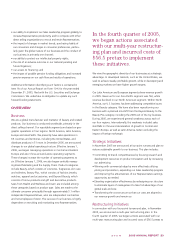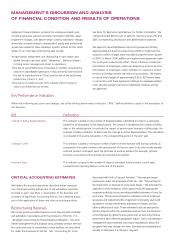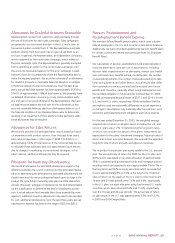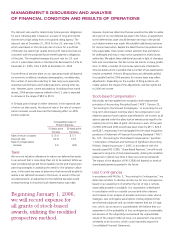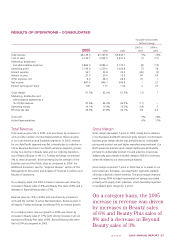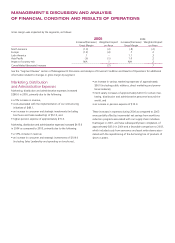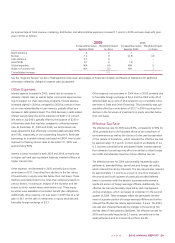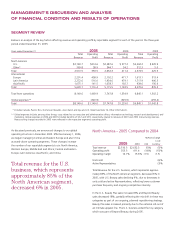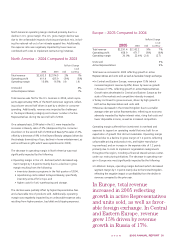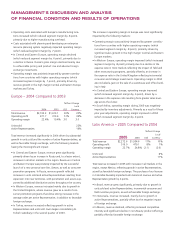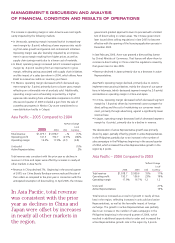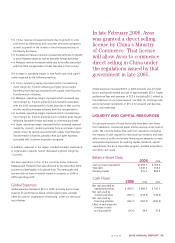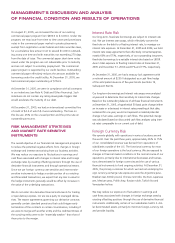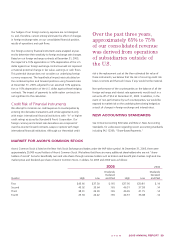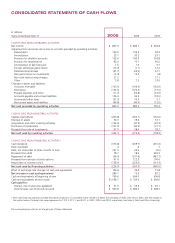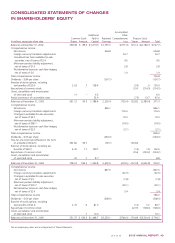Avon 2005 Annual Report Download - page 13
Download and view the complete annual report
Please find page 13 of the 2005 Avon annual report below. You can navigate through the pages in the report by either clicking on the pages listed below, or by using the keyword search tool below to find specific information within the annual report.
2005ANNUALREPORT33
Latin America operating margin declined due to an unfavorable
expense ratio of 2.1 points, mainly affected by increased fixed
expenses, primarily salaries, and costs related to the implementa-
tion of restructuring initiatives. Gross margin was consistent with
the prior year as benefits from supply chain efficiencies were
offset by the impacts of unfavorable pricing and product mix and
higher obsolescence expense. Operating margin was also nega-
tively impacted by lower contributions from countries with higher
operating margins (which decreased segment margin by .7 point),
primarily driven by lower revenues in Mexico.
In Mexico, operating margin decreased (which decreased segment
margin by 1.3 points), primarily driven by a higher expense ratio due
to lower revenue, higher administrative expenses, costs to imple-
ment organization restructuring initiatives, and increased consumer
related investments, partially offset by a gain on the sale of prop-
erty. Additionally, operating margin was impacted by a lower gross
margin resulting primarily from an unfavorable mix of products sold,
higher obsolescence expense and pricing investments.
In February 2004, the Venezuelan government devalued the
Venezuelan bolivar (“VEB”) from 1598 to 1918 VEB for one U.S.
dollar. The currency remained stable for the remainder of 2004 but,
in February 2005, the Venezuelan government again devalued the
official exchange rate to 2150 VEB for one U.S. dollar. The currency
restrictions enacted by the Venezuelan government in 2003 limit
the ability of our subsidiary in Venezuela (“Avon Venezuela”) to
obtain foreign currency at the official rate to pay for imported
products. The lack of foreign currency has required Avon Venezuela
to rely on parent company support in order to continue importing a
portion of its material for its operations. Avon Venezuela’s results of
operations in U.S. dollars have been and are expected to continue
to be negatively impacted until foreign currency is made readily
available to importers. In spite of the difficulty in obtaining foreign
currency for imports, in 2004, Avon Venezuela remitted dividends
and royalties to its parent company at the official exchange rate. At
December 31, 2005, Avon Venezuela had cash balances of approxi-
mately $89.0, of which a significant portion is awaiting government
approval for remittance.
We use the official rate to translate the financial statements of Avon
Venezuela into U.S. dollars. In 2005, Avon Venezuela’s revenue and
operating profit represented approximately 3% and 6% of consoli-
dated revenue and consolidated operating profit, respectively.
Latin America – 2004 Compared to 2003
%/Point Change
Local
2004 2003 US$ Currency
Total revenue $1,934.6 $1,717.9 13% 14%
Operating profit 479.1 406.3 18% 21%
Operating margin 24.8% 23.7% 1.1 1.1
Units sold 11%
Active Representatives 11%
Total revenue increased in 2004 with increases in nearly all
markets in the region, reflecting growth in units sold and active
Representatives, partially offset by the negative impact of foreign
exchange, primarily in Venezuela and Mexico.
• In Brazil, revenue increased, primarily reflecting an increase in
units sold and active Representatives, driven by field sales incen-
tive programs and new product launches, as well as favorable
foreign exchange.
• In Venezuela, revenue increased significantly, primarily due to
growth in units sold and active Representatives, partially offset
by the negative impact of foreign exchange. Revenue also ben-
efited from field sales incentive programs and higher prices.
• In Argentina, revenue increased significantly, driven by growth
in active Representatives and units sold, reflecting new product
launches and consumer incentive programs.
• In Mexico, revenue increased, driven by growth in units sold and
active Representatives, almost entirely offset by the negative
impact of foreign exchange. Revenue benefited from new prod-
uct launches and field sales incentive programs.
In Latin America, total
revenue increased in 2005
with increases in all markets
in the region, except Mexico.
The purchase of our licensee in
Colombia favorably impacted
the region’s revenue growth
by 2 points.


